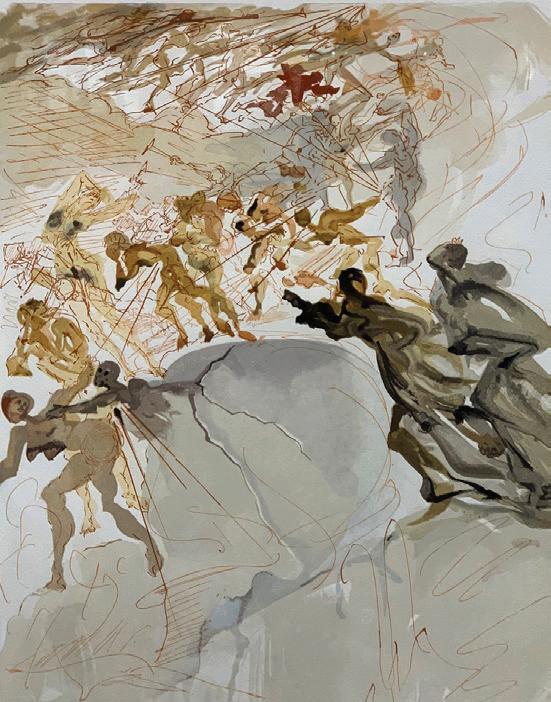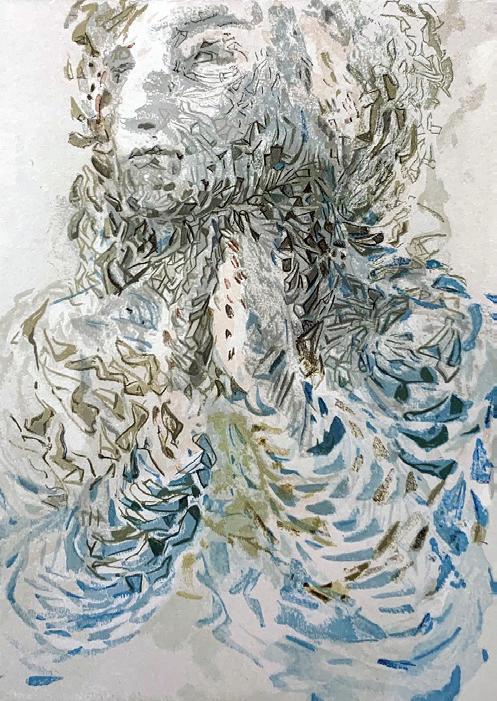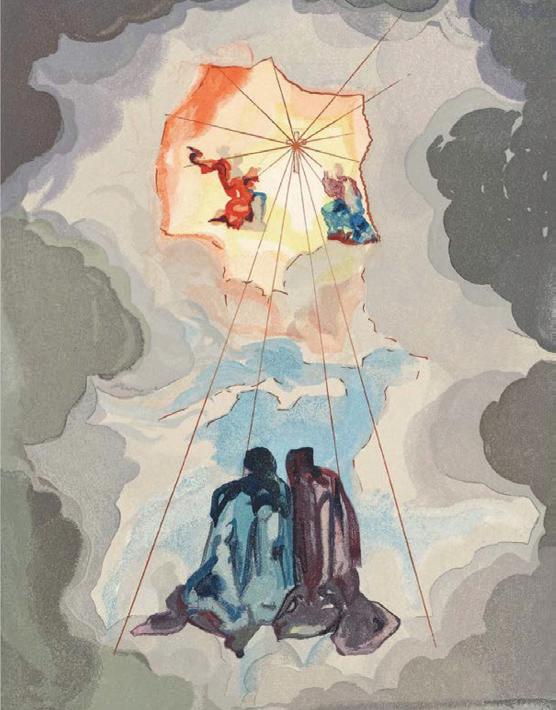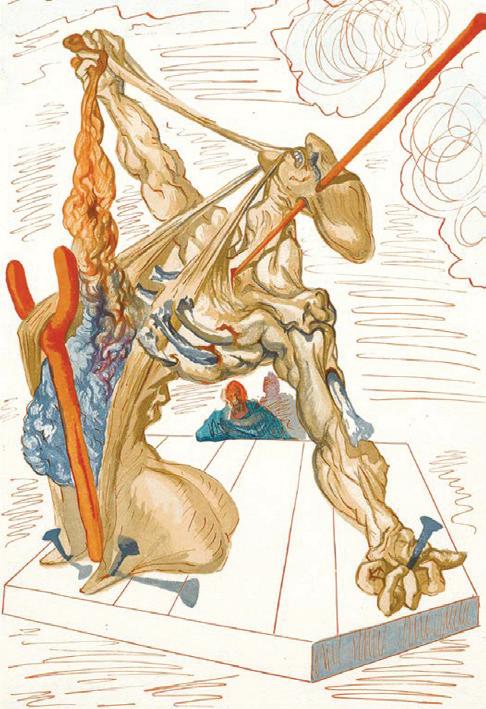
7 minute read
ART El Museo Latino
A R T Hello, Dalí! Hello, Dalí!
El MusEo latino wElcoMEs thE spanish MastEr salvador dalí with largE “Stairway to Heaven” print show
By Janet L. Farber
Asked to name Spain’s most famous artists, one might come up with a quick but succinct list primarily from the early 20th century: Pablo Picasso, Joan Miró and Salvador Dalí.
Considering their achievements in becoming household names, it may be no surprise that El Museo Latino would find ways to bring them to their broad audience as well. Last year, it featured ceramics by Picasso; on April 2, it opened Stairway to Heaven, a large exhibition of prints by Dalí.
The show consists of two different bodies of the artist’s work, the earlier of which is a cycle of blackand-white prints from squarely within the middle of his famous 1930s Surrealist period. Surrealism was an international artistic and literary movement, based largely in Paris, whose practitioners rejected rationalism and promoted the unleashing of the imagination through unconscious thought, dreams and fantasy.
Dalí in particular practiced what he called a “paranoiac-critical method” of producing images by inducing extreme states of delusion, in which objects and scenes were liberated from their normal descriptive functions. Hence, the melting clocks, elongated skulls and disembodied organs that come to mind in his most famous paintings of the time.
For those seeking this version of Dalí, his illustrations for Les Chants de Maldoror provide immense satisfaction. A poetic novel penned in 186869 by the Comte de Lautréamont (aka Isidore Lucien Ducasse), it featured an evil, misanthropic character and was run through with violence, perversion and depravity. The macabre text was rediscovered by the Surrealists and became Dalí’s first significant effort in book illustration.
The 43 intaglio prints he completed by 1934 are part of this show, appearing as single images as well as illustrations within the text. Although we are not told so, the artist was not entirely interested in trying to visualize the writer’s prose, but used it as a springboard for exploring his own hallucinatory visions. His dancing, calligraphic style is well at play in the etched lines forming an array of curious, often disturbing, characters.
The main event of the exhibition, however, is Dalí’s 100 color-print suite illustrating the Medieval poet Dante Alighieri’s Divine Comedy, which at 701 years old remains an unparalleled work of literature. Explanatory labels, which are abundant and quite helpful, outline how the project came to be and how it unfolded.
In a nutshell, Dalí was commissioned in 1950 by the Italian government, which was promoting a new edition to mark the 500th anniversary of Dante’s birth, and after many years of work creating 100 watercolors, found his project rejected. Fueled by his passion for the project and trading on his influence, Dalí found a willing publisher in France, Les Heures Claires. The watercolors were translated into wood engravings, and the publication appeared at last in 1965.
Dante’s great epic is divided into three sections: Inferno, Purgatory and Paradise, and so follow Dalí’s images. Dante is his own protagonist, and the text follows his journey from sin, through hell and purgatory under the wing of classical poet Virgil, to the penitent life and heaven with the guidance of his female ideal, Beatrice.
Dante’s odyssey is a complex and engaging mix of history, Medieval Christian theology and Greco-Roman mythology, and his descriptive language has lent itself well to illustration over the centuries. Inasmuch as Dalí’s surrealist phantasms made him well-suited to bringing the Inferno and Purgatory to life, so too did his reconciliation with Catholicism by 1948 make him recognized for a newfound religious expression in his art.
The exhibition, arranged in the order of the illustrations, begins with Inferno, in which Dante, the redcloaked protagonist, is introduced as a small but central figure in the center of a great open plain rendered in a long, raking perspective. This recurring landscape motif, it is explained, is the artist’s shorthand for the terrain of his youth in Spain, thus representing the beginning of a journey for both the portrayed and the portrayer.
Along the way, Dante confronts Cerberus, the three-headed dog that is the guardian of hell’s gates. Dalí’s “Cerberus” is a great, rearing steed, whose fearsome power and muscular energy is masterfully displayed through the whirling and concentric inky lines defining the beast.
Most reminiscent of the artist’s surrealist work are prints such as “Falsifiers,” one of his most violent illustrations of Dante’s most despicable sinners. It depicts the half-flayed torso of a human nailed to a board, pierced with a lance, grabbing its own entrails. Nothing is spared in this vision of a “justly” tortured soul, one that seemingly could only emerge from Dalí’s excursions into paranoiac-critical methodology.
Similarly, the Purgatory cycle investigates the nature of sin and the road toward redemption, as Dante is guided up the mountain of Purgatory toward heaven. The Seven Deadly Sins make their appearance here, including the cacophonous “Rising to the Seventh Level: Lustful.” The scene, rendered in washy tones of sepia and ochre, is filled with naked, tormented figures fleeing flames of fire, which Dalí has reconceived as linear shooting rays. Depictions such as this also display his knowledge of Renaissance and Baroque religious painting, calling to mind apocalyptic scenes of the Last Judgment.
Proving that Purgatory is not all doom and gloom for our hero, glimpses of redemption are envisioned. In particular, “Dante Purified” is a simple image of devotion. Dante is seen through the hollowed center of a brilliant blue angel, its large wings the colors of the rainbow. Dante stands again on the Spanish plain, with the viewer understanding that he will leave terra firma on the next leg of his quest.


LEFT: “Rising to the seventh LeveL: LustfuL,” fRom the Divine ComeDy, PuRgatoRy, 1960, wooD engRaving in CoLoR on Rives PaPeR afteR a wateRCoLoR, 10 x 7 1/4 in. RIGHT: “the Divine foReknowLeDge” fRom the Divine ComeDy, PaRaDise, 1960, wooD engRaving in CoLoR on Rives PaPeR afteR a wateRCoLoR, 9 1/2 x 6 7/8 in.


LEFT: “Dante’s ecstasy,” from the Divine comeDy, ParaDise, 1960, wooD engraving in color on rives PaPer after a watercolor, 9 3/4 x 7 3/8 in. RIGHT: “falsifiers,” from the Divine comeDy, inferno, 1960, wooD engraving in color on rives PaPer after a watercolor, 10 x 6 7/8 in.
FRIENDS AND FAMILY SALE
SCHEDULE YOUR EYE EXAM TODAY! 877-457-6485

Consider “Dante’s Ecstasy” in the Paradise section. In the text, it represents the poet’s celestial reunion with his forefathers, and Dalí has recast this particularly divine moment in the recognizable visual language of ascension to heaven. It is also a beautiful example of Dalí’s broader and washy watercolor style and brighter palette that characterizes the later illustrations. Whether this loosening of imagery is a kind of stylistic symbolism attached to Dante’s travel from hell to heaven or indicates Dalí’s fatigue with the enormity of the project is unclear; it could certainly be read either way, but it is enormously effective for this heightened emotional moment in the poem.
Finally, the show’s introductory materials comment on Dalí’s “nuclear mysticism,” which by this time in his career encompassed themes including religion and the scientific process, particularly nuclear fission/ fusion. Though the religious aspects of the Divine Comedy illustrations are clear, the scientific interests are less apparent. In Paradise’s “The Divine Foreknowledge,” Dalí depicts the poet learning of his fate to exile with clasped hands, and with a seemingly atomic fracturing of his being into small energized shards.
All in all, the exhibition offers much to take in. It is rich with literary connections and considerations of how a visual artist might interpret an author’s text. It is also a visual history of Salvador Dalí’s art, taking the viewer through his many stylistic phases and recognizable images. Given the time it should take to thoroughly digest this large show, it proves worth the journey.
Salvador Dalí’s “Stairway to Heaven” runs through Aug. 14 at El Museo Latino, 4701 S. 25th St. Current museum hours are Wednesday-Friday, 11 a.m.-5 p.m.; Saturday 11 a.m.-2 p.m.; reservations are required by calling 402-731-1137 or going online to www.elmuseolatino.org.

Malbar.com/good
*Requires purchase of a complete prescription pair, including frame and lenses. Does not include sunglass frames, Oakley, RayBan, Maui Jim, Chanel, Oliver Peoples, Michael Kors, Tiffany & Co., Cartier, Tom Ford, Cutler and Gross, accessories, contact lenses, or medical procedures. Cannot be combined with any other discounts, promotions, or insurance plans. Not valid on previous orders. Other restrictions may apply. See practice for full details. Offer ends 06/13/2021. 21MBR-127854
YOU ARE NOT ALONE...
WE’RE ALL IN THIS
10:50 am Live-Stream Service via Facebook
@ www.facebook/FUMCOmaha
7020 Cass Street 402.556.6262 www.fumcomaha.org




